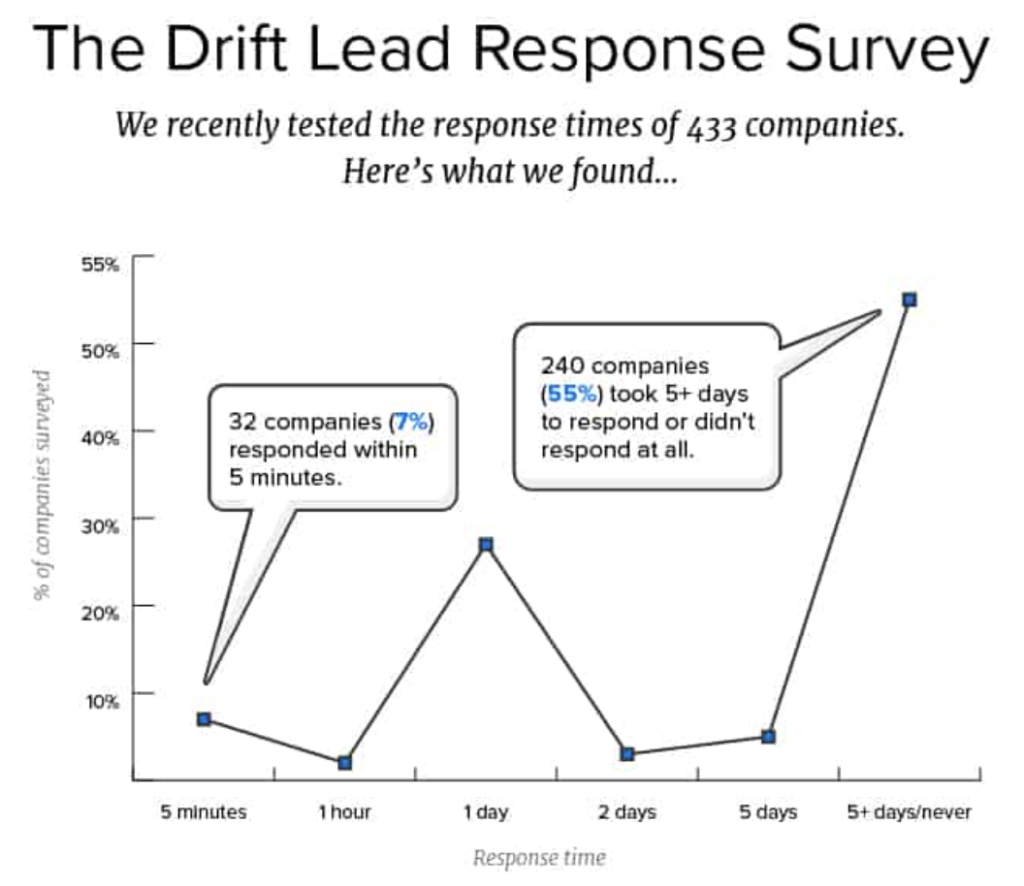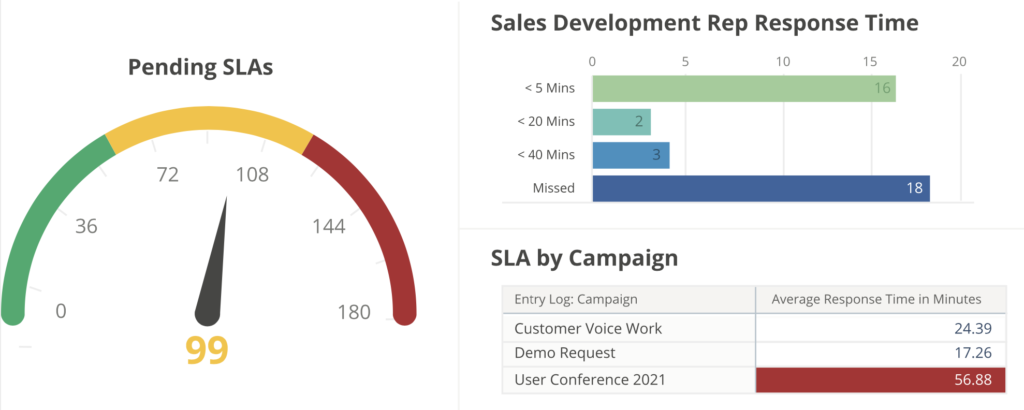Managing SDR productivity with SLAs (service level agreements) is one of the smartest things a sales leader can do.
Sales development representatives (SDRs) perform the prospecting part of sales processes, setting up meetings and demos, qualifying leads, and identifying sales opportunities.
SDRs are responsible for the front end of the journey, setting the table for AEs to succeed.
In this article, we’ll show you how to improve SDR performance, as well as improve the handoff between Marketing and Sales, SDRs and AEs.
What’s an SLA?
One of the key accountabilities in an SDR’s performance is their speed to lead.
That’s the speed in which engagement with the prospect occurs. Benchmarks for lead response time are set by a number of factors, including the lead source, and an effective way of managing performance is by establishing a service level agreement (SLA).
Generally speaking, an SLA is a contract defining how two organizations or teams will work together. In relation to Sales and Marketing teams, SLAs are usually multi-directional. They detail how Sales will respond to Marketing-generated leads in order to achieve higher conversion rates.
In addition, they reflect marketing goals, like the number of leads generated or pipeline built. SLAs detail the timing of sales activities, like the engagement of leads that were qualified by the marketing team.
An SLA agreement is built on specific, quantifiable goals. It documents the commitment of each functional group to support one another and drive toward overall revenue goal attainment.

Different leads have different SLAs
Not all leads are created equal, and therefore, not every lead should have the same SLA with regards to outreach and engagement.
Perhaps the hottest of all leads are demo requests, as potential buyers essentially raise their hands as an indicator to wanting to learn more about a company’s product, solution and/or service.
As you’re likely not the only vendor being reached out to, your speed to lead with demo requests is paramount in blocking out your competition.
Best practice in responding to inbound demo requests is five minutes or less.
According to a study by Drift of 433 companies, only seven percent of companies responded to leads in five minutes. Additionally, 55 percent took five days or more to respond.
That means you have a great shot at engaging the lead before any of your competitors.

The bad news is that practically everyone knows the importance of lead response time. Companies in every industry are rapidly deploying solutions to decrease response time appropriately.
So, increase your speed to address this opportunity!
However, not every lead requires a five-minute lead response time. For example, leads often download an ebook or register for a webinar to first educate themselves by using the resources you’ve already made available. Hence, they are not ready for your SDRs.
It often does not make sense to contact them before they’ve had an opportunity to read the ebook or attend the webinar/watch the recording on-demand. A more appropriate lead response time might be measured in hours or days, or relative to their attendance rather than registration.
Manage SDR Productivity with SLAs
You’ve set your benchmark targets for lead response time based on lead type and lead source, and you’ve defined your internal SLAs. That answers the question, “So, what?”
The next question to answer is, “Now, what?”
Next, you have to put in processes to manage your SDR lead outreach in accordance to your SLAs. SLA compliance is impacted by a variety of factors, from unbalanced work loads to time management and performance issues. But, before systemic adjustments or coaching can take place, an SDR leader needs sound SLA data, including:
- Average and median response times by lead type and lead source, as well as by role (SDR, AE, etc.)
- SLA compliance by campaign and geographic region
- Real-time data on current SLAs that are expiring
However, reporting out on SLA compliance can be a daunting challenge for many organizations, as manual processes can be extraordinarily time-consuming.
The cost-effective solution, like so many in your go-to-market (GTM) processes, lies in automation.

Drive increased speed to lead with automated lead management
At LeanData, we have built-in tools in our industry-leading routing solution to automate SLA accountability and track compliance. These tools eliminate the need for time-intensive manual processes, and allows your selling professionals to focus their time and attention to more value-added selling activities.
When building automated flows within LeanData, Operations professionals can easily drag and drop nodes into their processes that hold leads from moving forward until very specific conditions are met.
This functionality is critical for SLA compliance. Those conditions for movement can include actions like holding a record until its lead status field has been changed (for example, after an SDR has actioned the lead). Or, the conditions may feature a time-based component, holding a lead in the flow until an SLA time has elapsed. Then, the flow moves the lead to another representative, automatically notifying both the SDR and SDR manager.
Below are three common SLA challenges that are solved with LeanData SLA automation and tracking.
1) Improve lead response time by automating time-based actions
Build time-based automation into your GTM process with nodes to add timestamps or hold records until specific conditions are met. When records receive a specific update or a defined time limit expires, your automated process decides what happens next. Automatically reassign leads, send notifications and reminders about hot leads, or initiate automatic responses to prospects or customers.
2) Route leads after enrichment
When receiving leads through multiple channels, build in enrichment prior to routing. This ensures SDRs have contextual insight into the account prior to making first contact. Holding a record until after it has been enriched also ensures that speed to lead is measured only after the lead is properly prepared for the SDR – your SDRs should always have relevant engagements, not just timely ones. After enrichment, reinsert the lead into your GTM process to route it to the most appropriate representative.
3) Monitor SLA compliance to manage SDR productivity
Automatically track how long your process is taking for each lead, and how quickly your team is working those leads. Hold Until nodes in your process automatically track how long a record is waiting until it meets your specific predetermined conditions, and those same nodes also track whether or not your defined SLA was met. Additionally, you can also customize the information recorded in your logs for better insight into any bottlenecks.
Summary
Your speed to lead has a critical impact on the success of your GTM strategies, as a fast lead response time not only delivers an ideal customer experience, it also helps block out your competition.
However, proactively managing response time – in real time, no less – with SLAs can be extraordinarily difficult with manual processes. Automate your GTM motions to unlock the power of speed and grow your customer base and revenue faster.











